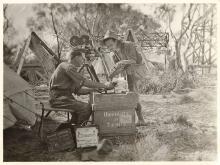Listen to today's episode of StarDate on the web the same day it airs in high-quality streaming audio without any extra ads or announcements. Choose a $8 one-month pass, or listen every day for a year for just $30.
You are here
Moon and Venus
Early risers are in for a treat tomorrow: a close encounter between the crescent Moon and Venus, the “morning star.” They’re in the southeast at dawn.
The two bodies will move even closer during the day. In fact, they’ll get as close as possible: The Moon will occult Venus — it’ll pass directly in front of the planet, blocking it from view. The event will be visible across part of the western United States — but not easily visible.
Such occultations aren’t rare. Venus and the Moon both stay close to the ecliptic, which is the Sun’s path across the sky. So they pass close to each other every month. And when the lineup is just right, there’s an occultation.
This one takes place in the afternoon or early evening here in the United States. From much of the country, Venus and the Moon will set before the cover-up begins, or the geometry won’t be quite right. But from parts of the west, everything lines up just right. From San Francisco, for example, Venus will disappear about 1:15 p.m. and stay behind the Moon for an hour.
It’s not an easy thing to see — you need to look carefully to find the Moon in the bright sky. And you need to make sure to not look too close to the Sun. Venus and the Moon are about 25 degrees from it — more than twice the width of your fist at arm’s length.
The Moon is heading toward the Sun, though. It’ll pass in front of it on Monday — creating a total solar eclipse for parts of the southern hemisphere.
Script by Damond Benningfield





